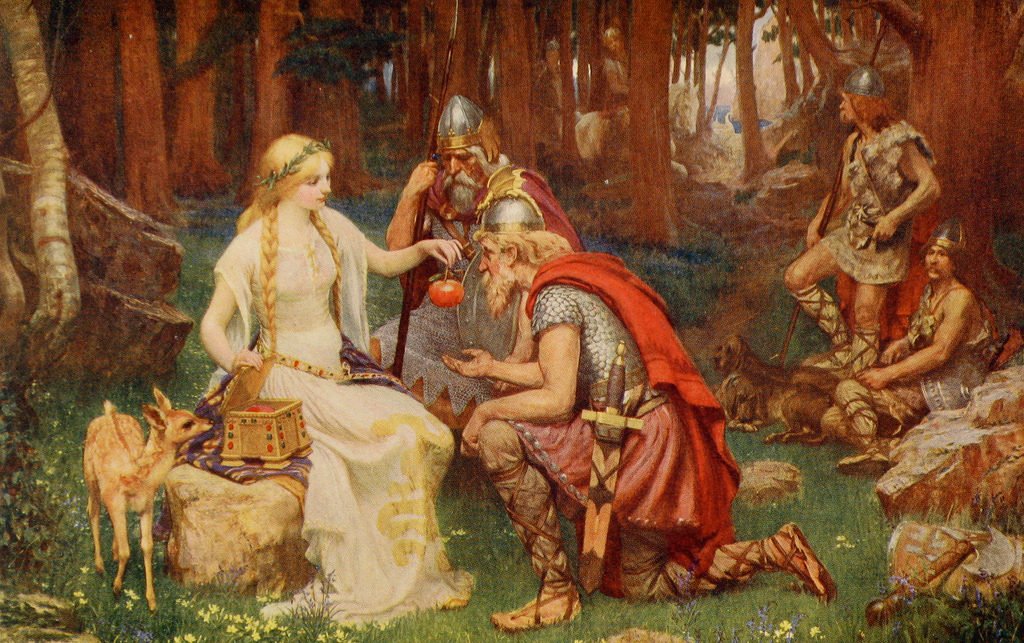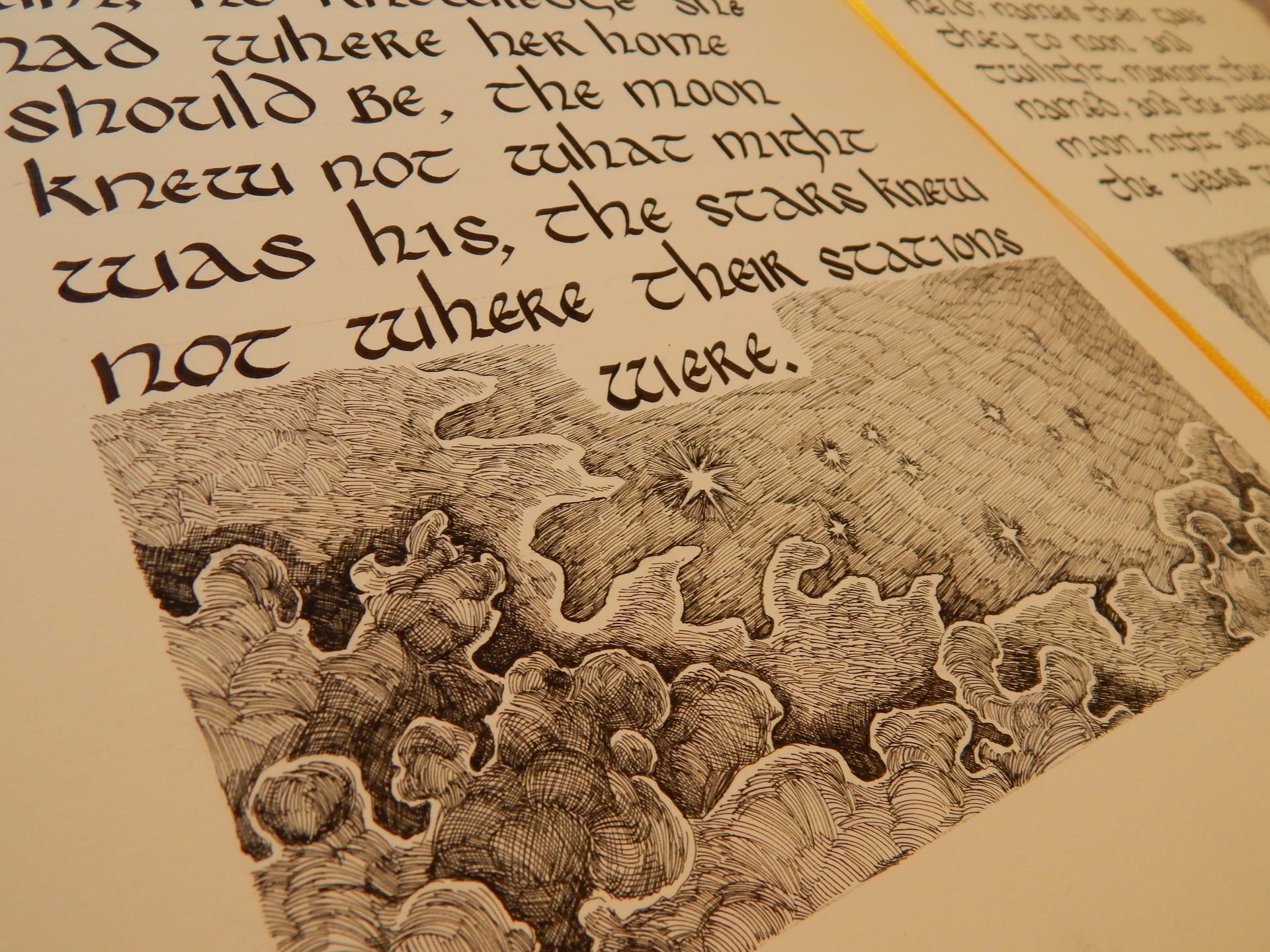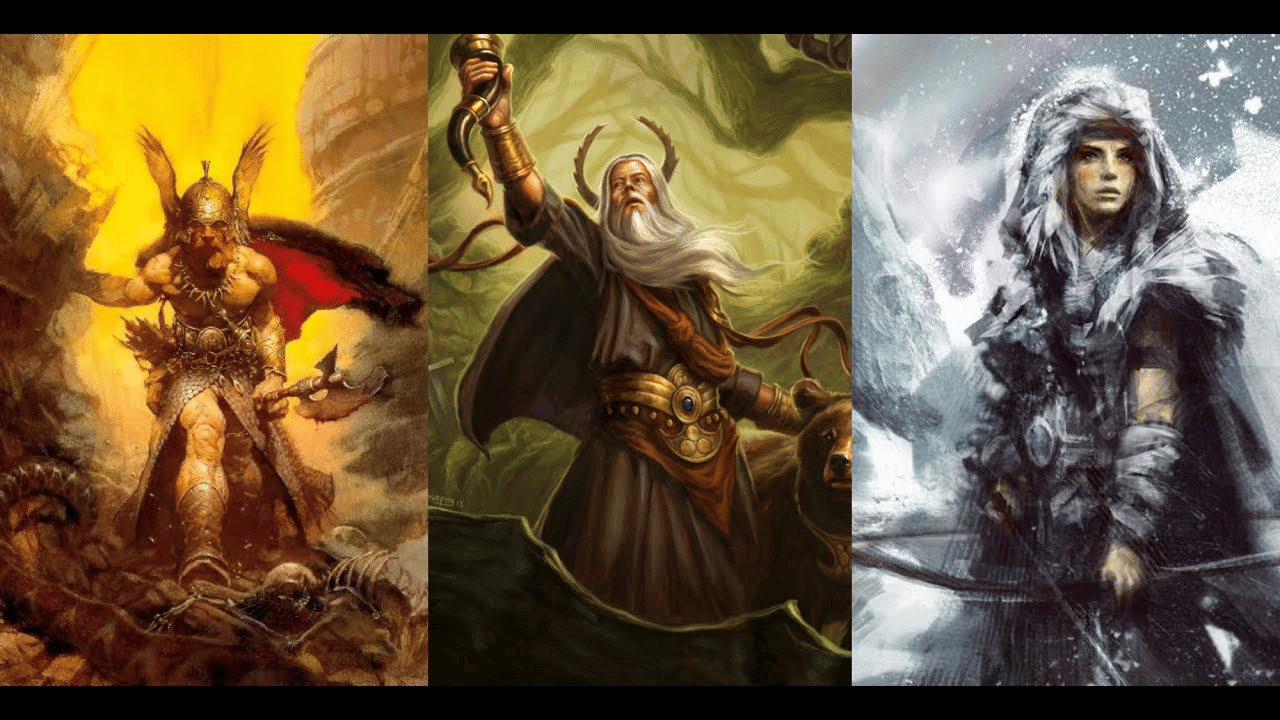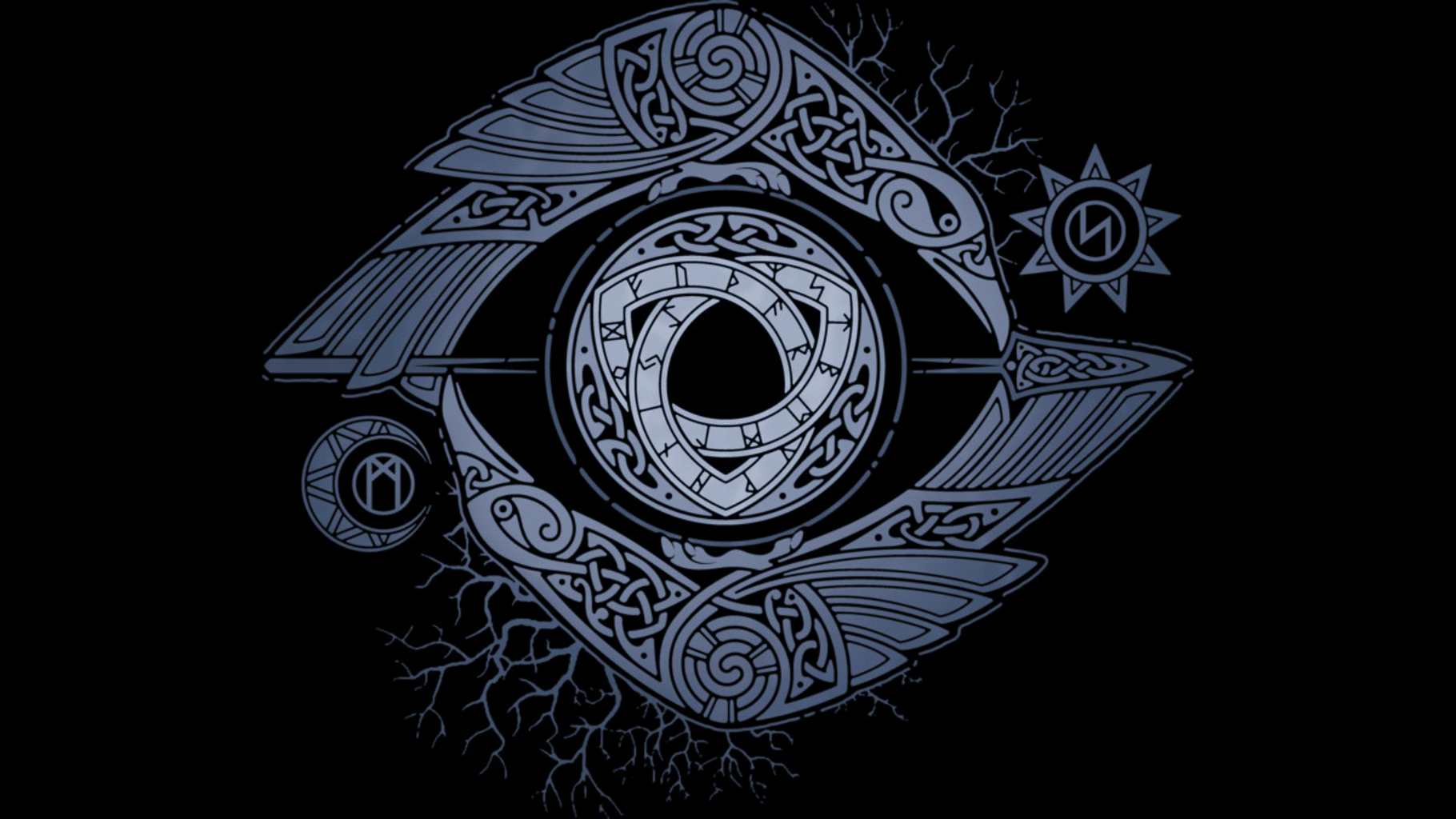
El Voluspa (Old Norse: Vǫluspá) is a medieval poem from the Edda poems, describing how the world would have been formed and destroyed, according to Norse mythology. The story, of about 60 stanzas, is told by a seer or völva (Old Norse: valve, Also called spakona, 'seer woman'), summoned by the god Odin, master of magic and knowledge. According to this literary text, at the beginning of the world there was nothing, until the gods created the nine kingdoms of Nordic cosmology, connected in some way by the world tree, Yggdrasil.
At the same time, the fate of the complex was carved in stone by a group of seers. At first, two families of gods were embroiled in a war, which ended in a truce and a wall around their divine citadel of Asgard. However, they would not live in peace forever, since the universe was doomed from the moment of its creation. Each god has a specific enemy, against which he will fight, and many of them will be defeated, including Odin, the main god.

Context
The first poem, in the Edda collection of poems
It is known as Völuspá, which means: "Völva's prophecy". The Northmen of the XNUMXth or XNUMXth century, whom we usually call Vikings, really had no written sources for their religion. They carved some stone images, made wooden idols, and recited poems about what they thought the world was like. A few centuries after the era of these bold sailors, traders and explorers, some Icelanders wrote these poems, remembered by their ancestors. This collection of poems is called Edda, our most valuable source of information on what the myths of the Northmen were.
It is written in Old Norse, the language spoken in Iceland, Norway, Sweden, and Denmark until the XNUMXth century. These poems are found in two manuscripts: the Codex Regius (the "Book of the King") and another book called hauksbok; but the order of the stanzas - the groups of four lines that make up the poems - seems more logical in the first book. The first poem in the collection is the Voluspa, which means "the prophecy of the völva". Snorri Sturluson, a XNUMXth-century Icelandic scholar, also wrote a version of these tales, quoting much of those poems in his book. The version known to him, however, seems different, indicating that the poems by Edda They were very popular with the Vikings.
how the world was born
According to Voluspa, Odin, the leader of the Æsir gods, as the first and most powerful divine family was called, was always eager to know. He asked a völva, an ancient seer, to rise from the grave and tell him the stories of the past, the father of the fallen (Valfǫþr), since it is he who brings warriors to his famous hall in Valhalla. She responds by mentioning the nine worlds that make up the universe and the Yggdrasil tree, and also tells him about Ymir, a giant from whose limbs the universe was created.
In the beginning of time, there was a "great chasm" (Hildebrand, stanza 3). The creation of the universe seems to have been the work of Borr's sons: Odin and his brothers Vili and Vé, whose names we know from another poem. The three brothers shaped the land, took their seats in the Assembly, and then They named the stars in the heavensthus giving order to the universe. The gods met at Ithavoll, a mysterious place mentioned only twice in the poem, where they established forges, made tools, and built temples.

The result of the war between the Æsir and Vanir families of gods was that all gods received the same right to worship
At his abode, three giant maidservants arrived, a possible reference to the norns, who were creatures even more powerful than the gods, as they decided the fate of all. A council was held at which a catalog of the dwarf race was handed out; very few of them are mentioned elsewhere. One of them, Gandalf, was transformed into a wizard by Tolkien in " The Lord of the Rings ».
Another important name is dvalin, who seems to have given the dwarves magical runes that made them very skilled, as told in the second poem of the Edda, Havamál. Then we have Andvari who, in a poem called Reginsmal, tells how Loki, the trickster god, stole his wealth, causing him to curse the treasure which led to Sigurd's death. The latter is the tragic legendary hero, who slew a dragon with a cursed treasure and who inspired many authors, including, once again, Tolkien. After this section, with many dwarves, three gods -Odin, Hönir and Lothur- continued their work and created humanity from two trees, the ash and the elm (Ask and Embla). The fates reappear in stanza 20, where they carve runes into wood and make laws.
The first war in the world
The prophetess then relates what she remembers as the first war in the world, between the divine families of the Æsir and the Vanir. This last family is rather linked to fertility and prosperity, although it must be said that the Nordic deities, in general, cannot be limited to well-defined characteristics. In any case, the history of the Voluspa mentions the goddess Gollveig ('Power of Gold') as the reason for the war, since she was accused of seducing the gods. The result of this war was that all gods received equal worship, perhaps an allusion to their acceptance of other regional deities into their belief system.
With a quick change of subject, we get a glimpse of other major mythical events, such as the rebuilding of Asgard, the stronghold of Odin and his family, and perhaps one of the nine worlds the prophetess spoke of. When the giant, in charge of this task, asks Freyja, the goddess of love, as a reward, Loki is invited to play a trick on him, to prevent this from happening. Unsurprisingly, the giant ends up slain by Thor, the mightiest of the gods, angering the giants who eagerly fight the Æsir. The giants were actually another family of gods - their name does not refer to their size - and many of these were romantically linked to the gods of the Æsir family.

World's End
"Would you like to know more?" (Hildebrand, stanzas 27, 29, 34, 35, 39, 41, 48, 62). This question comes up periodically, reminding us that Odin is the god who is always seeking to acquire knowledge. Heimdall's horn, which will announce the final battle, is hidden under the sacred tree, where we find another curious object, Odin's eye. He sacrificed his eye to the spirit Mímir, to gain more wisdom. It seems that the eye was then used as a drinking vessel. After being rewarded by the god with rings and necklaces, the völva continues with the true prophecy of the poem. She sees the Valkyries assembled, joining the ranks of the gods for the final battle. The Valkyries are warriors, commissioned by Odin to collect the brave fighters who died in battle and bring them to him.
Before this great event, whose destinies are about to be fulfilled, we are reminded of the catastrophe that was the death of Baldr, the beloved, just and innocent son of Odin and Frigg. More details of this event are found in a particular poem, Baldrs Draumar. Frigg asked all the creatures to swear not to harm Baldr, which they all did, except Baldr's blind brother, who hurled mistletoe at him, under Loki's direction. After Baldr was killed with the mistletoe arrow, loki was punished, and we have a fuller picture of his punishment in the manuscript of hauksbok: this one was tied to a rock with the entrails of his son Narfi, mutilated by his other son Vali, with a snake dripping poison on him and his faithful wife, who tries to collect it in a bowl.
corpse rod
After describing the homes of the gods' fearsome enemies, including not only giants and dwarves, but also the wicked dead of the Nastrond ('corpse rod') realm of Hel, the völva Warns of another sign of destruction: stealing the moon. It would not be wrong to interpret this as an eclipse. The final battle will be announced by the two apocalyptic roosters: Fjalar and Gollinkambi. Perhaps, one of the last signs of imminent death will be the escape of Fenrir the wolf, the one chained by the sacrifice of the god Tyr, who let that beast bite his hand. Dark times will come: "Era of the wind, era of the wolf / soon the world will fall / not even men / will forgive each other" (Hildebrand, stanza 45). Odin, no matter how much wisdom he has gathered, Fenrir will kill him. Yggdrasil is shaking.
Name «ragna rok» Ragnarok, used to describe this great event, can be translated as the "fate of the gods" and is found in stanza 50. Other elements of chaos include: Hrym, the leader of the giants; Midgardsorm, the sea serpent that encircles the world; and Naglfar, the terrifying ship made from the nails of dead men. The giant Surt brings fire from the south and fights against the god of prosperity Freyr, while Odin fulfills his destiny before his unfortunate wife Frigg. Even Thor, son of Odin and the earth, is destined to fall in this great battle against the sea serpent, which will kill him with its poisonous breath. The apocalypse gains momentum after the episode involving the most popular of gods, after: "The sun turns black / the earth sinks under the sea / the warm stars fall from the sky"
Conclusions
Is this really the end, with humanity lost and the gods defeated? Nope; according to the poem, the world will resurrect, because there are still some gods who meet and talk about the latest events and the fall of Odin, the master of the runes. His son Baldr will return, the fields will once again be full of ripe fruits and Odin's grandsons will dwell in heaven. On Gimle Mountain, a great golden hall can be seen, inside of which is a powerful nameless ruler.
It sounds like a pretty intense story but, like many other aspects of Norse mythology, many pieces of the puzzle are missing and it has been suggested many times that Christianity may have influenced the last part of the poem. Although it is difficult to clarify, most likely the poet was a pagan, as suggested by the tone, imagery, archaic language features, and style of the poem. It must also be said that much of the Norse myth of creation and destruction, which persists even in today's popular culture, actually derives from Snorri's interpretation, which transforms all those hints of the poem into a much more coherent story.